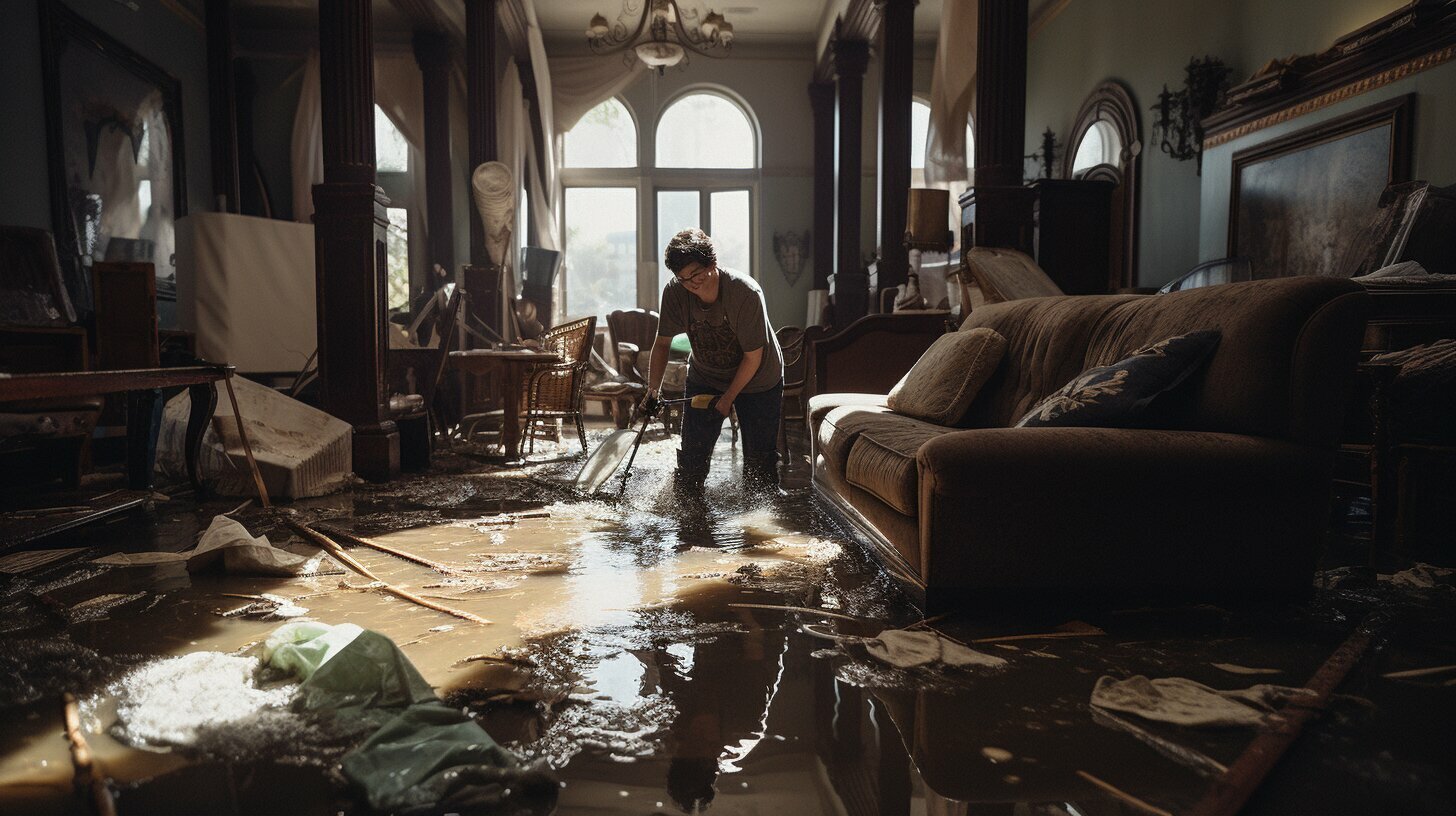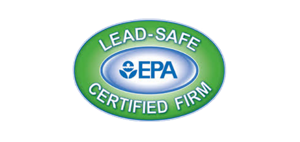Cleaning up after flood damage can be a challenging task, but with the right approach, you can effectively restore your home and prevent further issues. Before beginning the cleanup process, prioritize safety by turning off gas and electricity and wearing protective gear such as rubber boots and gloves. Ensure the flooded area is safe to enter and then follow these steps to start the restoration:
- Remove standing water and all soaked materials, including furniture and carpets. Shovel out mud.
- Scrub walls and floors with household cleaners and disinfect them with a bleach solution.
- Remove interior wall finishes and insulation to allow for the release of water and mud from wall cavities.
- Clean and disinfect walls and floors thoroughly. Use dehumidifiers to speed up the drying process, which may take several months to complete.
- When cleaning the basement, pump out the water gradually to avoid structural damage.
- Document the extent of the damage for insurance claims and contact your insurance company promptly.
- Organize a cleanup crew to assist with the process and adopt a step-by-step approach to ensure an effective cleanup and restoration.
Key Takeaways:
- Prioritize safety by turning off gas and electricity, and wearing protective gear before entering the flooded area.
- Remove standing water, soaked materials, and mud.
- Scrub and disinfect walls and floors.
- Remove interior wall finishes and insulation to release water and mud from wall cavities.
- Utilize dehumidifiers to speed up the drying process.
Remember to document the damage for insurance claims, and contact your insurance company as soon as possible. By following these steps, you can effectively clean up and restore your property after flood damage.
Tips for Effective Flood Cleanup
To ensure a thorough and effective flood cleanup, it’s essential to follow these recommendations and guidelines. Cleaning up after flood damage can be overwhelming, but with the right approach, you can restore your property and get your life back on track.
Safety First: Before entering the flooded area, prioritize safety. Shut off gas and electricity to prevent accidents, and make sure to wear protective gear such as rubber boots and gloves to avoid contact with contaminated water and debris.
Remove Standing Water and Soaked Materials: Start by removing standing water using pumps and wet vacs. Then, dispose of all soaked materials, including furniture, carpets, and other items that cannot be salvaged. Shovel out mud and debris from your home, ensuring thorough cleaning.
Clean and Disinfect: Scrub walls and floors with household cleaners to remove any remaining dirt and grime. After cleaning, disinfect them with a bleach solution to kill bacteria and prevent mold growth. Additionally, consider removing interior wall finishes and insulation to facilitate the release of water and mud from wall cavities.
Speed Up Drying: Use dehumidifiers and fans to improve airflow and speed up the drying process. Keep in mind that it may take several months for walls and floors to dry completely. Monitor the moisture levels regularly and take necessary measures to prevent mold growth.
Basement Cleanup: If your basement is flooded, pump out the water gradually to avoid structural damage. It’s crucial to clean and disinfect the basement thoroughly to prevent future issues.
Document and Inform: Document the flood damage by taking photographs and making a detailed list of the affected areas and items. This information will be essential for insurance claims. Contact your insurance company as soon as possible to report the incident and start the claims process.
Organize a Cleanup Crew: Cleaning up after a flood can be a massive undertaking, so consider organizing a cleanup crew to assist you. By dividing tasks and implementing a step-by-step approach, you can effectively clean and restore your property in a systematic manner.
| Step | Action |
|---|---|
| 1 | Ensure safety by shutting off gas and electricity, and wear protective gear |
| 2 | Remove standing water and dispose of soaked materials |
| 3 | Scrub and disinfect walls and floors |
| 4 | Use dehumidifiers and fans to speed up drying |
| 5 | Clean and disinfect the basement |
| 6 | Document the damage and contact your insurance company |
| 7 | Organize a cleanup crew and follow a step-by-step approach |
Conclusion
Cleaning up after flood damage requires careful planning, proper safety precautions, and a systematic approach to restore your property successfully. The first priority is safety, so make sure to shut off gas and electricity before entering the flooded area and wear protective gear like rubber boots and gloves.
Once you have taken the necessary safety measures, the next step is to remove standing water and all soaked materials, including furniture and carpets. It is also important to shovel out mud and debris to prevent further damage.
To effectively clean and disinfect your home, scrub the walls and floors with household cleaners and disinfect them with a bleach solution. In some cases, you may need to remove interior wall finishes and insulation to allow for the release of water and mud from wall cavities.
After cleaning and disinfecting, it is crucial to use dehumidifiers to speed up the drying process. Keep in mind that it may take several months for the walls and floors to dry completely.
When cleaning the basement, pump out the water gradually to avoid structural damage. It is also important to document the damage for insurance claims and contact your insurance company as soon as possible.
Finally, organizing a cleanup crew can greatly assist with the process. Implement a step-by-step approach and delegate tasks to ensure an efficient and successful cleanup and restoration of your property.
FAQ
How do I clean up after flood damage?
To clean up after flood damage, start by ensuring safety by shutting off gas and electricity, and wearing protective gear like rubber boots and gloves. Remove standing water and soaked materials, scrub walls and floors with household cleaners, and disinfect with bleach solution. Remove interior wall finishes and insulation, clean and disinfect walls and floors, and use dehumidifiers to speed up drying. Pump out water from the basement gradually to avoid structural damage. Document the damage for insurance claims and contact your insurance company. Organize a cleanup crew and implement a step-by-step approach for effective cleaning and restoration.
What should I do first when cleaning up after flood damage?
The first priority is safety. Shut off gas and electricity before entering the flooded area and remember to wear protective gear like rubber boots and gloves.
How can I remove standing water and soaked materials?
Use appropriate tools to remove standing water, such as a wet vacuum or pump. Dispose of all soaked materials, including furniture and carpets.
How should I clean and disinfect walls and floors after flood damage?
Scrub walls and floors with household cleaners to remove dirt and contaminants. After cleaning, disinfect with a bleach solution to kill bacteria and prevent mold growth.
Is it necessary to remove interior wall finishes and insulation?
Yes, removing interior wall finishes and insulation is necessary to allow for the release of water and mud from wall cavities, so they can properly dry.
How long does it take for walls and floors to dry completely after flood damage?
It may take several months for walls and floors to dry completely. Use dehumidifiers to speed up the drying process.
How should I clean the basement after a flood?
When cleaning the basement, pump out the water gradually to avoid structural damage. Follow the same steps of removing water, soaked materials, and cleaning and disinfecting surfaces.
What should I do to document the flood damage for insurance claims?
Take photos and videos of the damage, make a list of all damaged items, and keep receipts of any expenses related to the cleanup and restoration process. Contact your insurance company as soon as possible to report the damage.
Can I clean up after flood damage on my own or should I hire professionals?
While some minor flood cleanup tasks can be done on your own, it is recommended to hire professionals for thorough water damage restoration and to ensure proper cleanup and restoration techniques are followed.
How can I organize a cleanup crew to assist with the flood cleanup process?
Reach out to friends, family, or neighbors who are willing to help, or consider hiring a professional cleanup crew to assist you with the process.









